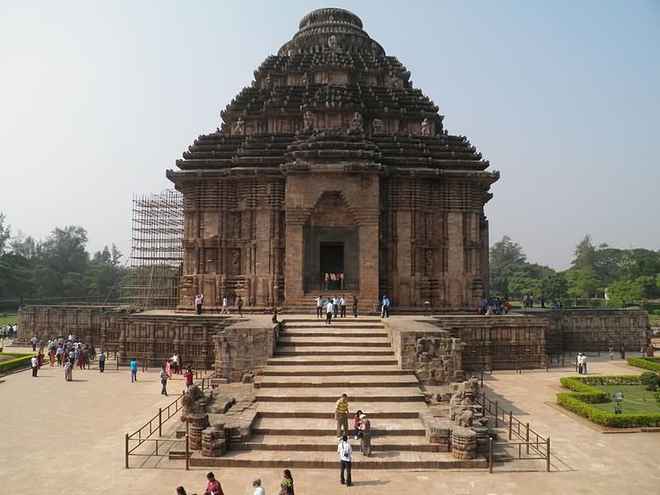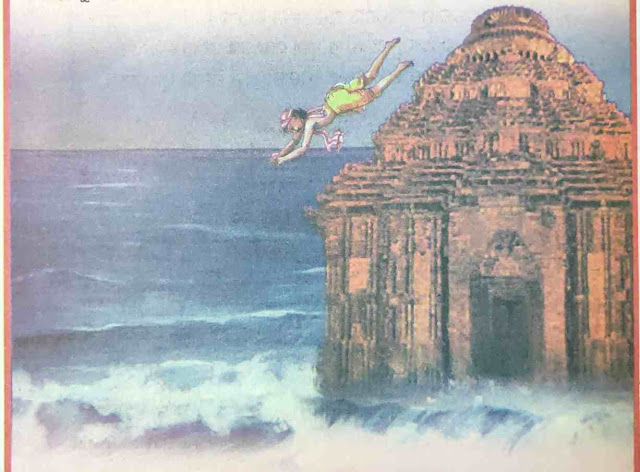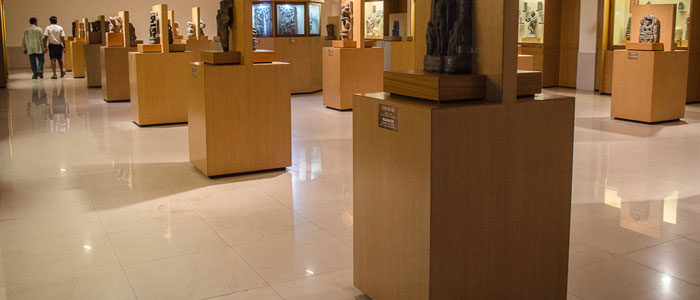1200 master craftsmen and 12 long years of dedication built a masterpiece that is has gone down in the annals of time. The Konark Sun Temple is one of the most magnificent architectural wonders built during the middle of the 13th century under the patronage of King Narasimha Deva I of the Eastern Ganga Dynasty. Situated at Odisha, Konark is a quaint town on the east coast of Bay of Bengal. This time, while we did the Diamond Triangle of Odisha, we visited Konark and Puri as well.
Konark Sun Temple is a 13th-century CE sun temple at Konark about 35 kilometres (22 mi) northeast from Puri on the coastline of Odisha, India. The temple is attributed to king Narasimha deva I of the Eastern Ganga Dynasty about 1250 CE.Dedicated to the Hindu sun god Surya, what remains of the temple complex has the appearance of a 100-foot (30 m) high chariot with immense wheels and horses, all carved from stone. Once over 200 feet (61 m) high, much of the temple is now in ruins, in particular the large shikara tower over the sanctuary; at one time this rose much higher than the mandapa that remains. The structures and elements that have survived are famed for their intricate artwork, iconography, and themes, including erotic kama and mithuna scenes. Also called the Surya Devalaya, it is a classic illustration of the Odisha style of Architecture or Kalinga Architecture.
The cause of the destruction of the Konark temple is unclear and remains a source of controversy. Theories range from natural damage to deliberate destruction of the temple in the course of being sacked several times by Muslim armies between the 15th and 17th centuries. This temple was called the "Black Pagoda" in European sailor accounts as early as 1676 because its great tower appeared black. Similarly, the Jagannath Temple in Puri was called the "White Pagoda". Both temples served as important landmarks for sailors in the Bay of Bengal. The temple that exists today was partially restored by the conservation efforts of British India-era archaeological teams. Declared a UNESCO world heritage site in 1984, it remains a major pilgrimage site for Hindus, who gather here every year for the Chandrabhaga Mela around the month of February.
Since the time of Mahammad Ghori, Odisha was raided several times by the Muslims, but the Hindu kings of Odisha could resist them definitely for a longer period. The Hindus were aware that it would be rather impossible for them to tackle with such a warrior nation and to drive them permanently out of their their country. Still they went on taking aggrasive parts in such a way, that they could delay the Muslim occupation in Odisha, for about two centuries more. By the middle of the 13th century, when the Muslims had conquered the whole of the northern India and most parts of neighbouring Bengal, there was hardly any power which could check their advance and it was thought that the Hindu Kingdom of Odisha would soon be overrun by them. At that time Narasimhadeva I started taking the offensive against them.
After the death of Sultan Iltutmish, in 1236 A.D., the throne of Delhi remained week for sometime, when Nasiruddin Mahammad succeeded him and appointed one Tughan Khan, a Governor of Bengal. A great fight took place between the Muslim army, under the said Tughan
Khan and Narasimhadeva I, at Katasin, in the year 1243 A.D., where the former were completely defeted and ran away. The heavy loss of lives in this war was so severe. Narasimhadeva's victory in this war must have enormously enhanced his prestige in the eyes of the contemporary Hindu Kings and as such, he wanted to build a temple to represent both, a shrine and a Kirti-Stambha (victory-memorial) to commemorate his victory according to his royal status and prestige.
The beauty of the Sun-rise and the roaring voice of the sea charmed Narasimhadeva since his early life. The river chandrabhaga which is now dead, was once flowing within a mile to the north of the temple site and was joining the sea. On its banks, existed flourishing towns and important trading centres. Trade was carried on with foreign countries as well, by sea routes, as there was no better communication other than the river in those days.
Narasimhadeva had preferred the place for his proposed temple, for not only enabling him to bring his building meterials from different places by the said river, but the sanctity of the was also considered by him. In this connection there is an interesting legend which says that, once Samba, the son of Sri Krishna, incurred the displeasure of Narada. Who revenged himself by getting Samba afflicted with leprosy.Ultimately, when Samba, was found innocent, he was advised to practice penance in the Maitreyi forest for 12 years, to please Surya(Sun God) to cure him of his disease. He acted accordingly and after the prescribed period the Sun appeared before him and asked to recite the twenty-one different names of the deity. Next morning when Samba was taking his bath in chandrabhaga, his hands came in contact with something in the water. He immediately lifted it up and saw an image of Surya (Sun God) standing on a lotus pedestal, holding two lotuses in his both hands. He carried the image to his Ashrama (hermitage) and installed it in a temple, built by him. Samba was however completely cured, after sometime, by worshipping the deity.Besides the sanctity and the favourable surroundings, the presence of majestic sea eternally roaring and rolling within a striking distance, was perhaps an added attraction for them.
The name Konark derives from the combination of the Sanskrit words Kona (corner or angle) and Arka (the sun).The context of the term Kona is unclear, but probably refers to the southeast location of this temple either within a larger temple complex or in relation to other sun temples on the subcontinent.The Arka refers to the Hindu sun god Surya.
This UNESCO World Heritage Site has been built in the form of a majestic and colossal chariot that is about to make its first flight. The King was the worshipper of the Sun god, and so the temple was made in the praise of the Sun God. The chariot was made in such a way that the Sun God himself was perceived to drive the chariot, he being seated inside the “Garbagriha” or the inner sanctum. The chariot is drawn by seven horses and twenty four wheels. Each horse denotes a day of the week and each wheel depicted the hours of the day.
The temple was made of three types of stones. The stones were mainly black in colour. The Konark Temple, when built, served as a beacon to the ships in the Bay of Bengal. The sailors could see the temple from the sea and they called the temple as Black Pagoda.
Just like any other ancient temples, the Konark Sun Temple also has are exquisite and interesting carvings all over the temple. Our guide explained to us in details about the carvings. Out of the seven horses, three were on the left and four on the right side of the temple. It is because of the unequal number of horses on either side, the chariot moves faster on one side; the chariot is supposed to move in the circular direction, just as the sun moves. As we started moving around the temple doing the “parikrama” in the direction of the Sun itself, we saw the various carvings and sculptures. The carvings are of intricate designs are rich motifs. We came across the idol of the Sun God.
We so very much wanted to go inside the main temple to see the main idol. The Sun God idol is said to be floating mid-air inside the main sanctum. How? Well, it was the said to be the trick of magnets and metals. Infact, there are stories that go on to say that many ships that sailed the Bay of Bengal when came near the Konark Temple were destroyed due to the pull of the magnet. We seriously do not know the veracity of this story, but we sincerely hope that this is just a figment of the imagination. It would be really sad to know that such a magnificent piece of art was also so destructive.
Nevertheless, the main door of the temple is sealed since long, the magnet too, is removed and the deities placed elsewhere! The temple would simply destructed to earth if the doors are not sealed. In our mind, we refused to believe so. It is actually the nonchalant attitude of our countrymen that often leads to the gradual ruin of these historical architectures.
The walls of the temple from the temple's base through the crowning elements are ornamented with reliefs, many finished to jewelry-quality miniature details. The terraces contain stone statues of male and female musicians holding various musical instruments. Other major works of art include sculptures of Hindu deities, apsaras and images from the daily life and culture of the people (artha and dharma scenes), various animals, aquatic creatures, birds, mythological creatures, and friezes narrating the Hindu texts. The carvings include purely decorative geometric patterns and plant motifs. Some panels show images from the life of the king such as one showing him receiving counsel from a guru, where the artists symbolically portrayed the king as much smaller than the guru, with the king's sword resting on the ground next to him.
The upana (moulding) layer at the bottom of the platform contains friezes of elephants, marching soldiers, musicians, and images depicting the secular life of the people, including hunting scenes, a caravan of domesticated animals, people carrying supplies on their head or with the help of a bullock cart, travelers preparing a meal along the roadside, and festive processions. On other walls are found images depicting the daily life of the elite as well as the common people. For example, girls are shown wringing their wet hair, standing by a tree, looking from a window, playing with pets, putting on makeup while looking into a mirror, playing musical instruments such as the vina, chasing away a monkey who is trying to snatch items, a family taking leave of their elderly grandmother who seems dressed for a pilgrimage, a mother blessing her son, a teacher with students, a yogi during a standing asana, a warrior being greeted with a namaste, a mother with her child, an old woman with a walking stick and a bowl in her hands, comical characters, among others.
The Konark temple is also known for its erotic sculptures of maithunas. These show couples in various stages of courtship and intimacy, and in some cases coital themes. Notorious in the colonial era for their uninhibited celebration of sexuality, these images are included with other aspects of human life as well as deities that are typically associated with tantra. This led some to propose that the erotic sculptures are linked to the vama marga (left hand tantra) tradition. However, this is not supported by local literary sources, and these images may be the same kama and mithuna scenes found integrated into the art of many Hindu temples. The erotic sculptures are found on the temple's Shikhara, and these illustrate all the bandhas (mudra forms) described in the Kamasutra.
Other large sculptures were a part of the gateways of the temple complex. These include life-size lions subduing elephants, elephants subduing demons, and horses. A major pillar dedicated to Aruna, called the Aruna Stambha, used to stand in front of the eastern stairs of the porch. This, too, was intricately carved with horizontal friezes and motifs. It now stands in front of the Jagannatha temple at Puri.
Myths and legends go hand in hand with all the ancient monuments of the country. You will definitely find interesting stories and folklores behind all these great architectures. Konark Sun Temple is also not an exception. But the legend here is a little unnerving. It tells the tale of a bright 12-year-old boy who sacrificed his life to save the lives of 1200 craftsmen. The King Narasimhadeva wanted to build a grand temple dedicated to the Sun God adjacent to the sea (Well, the sea ran very near to the temple during those days. Later, geographical upheavals have resulted in receding of the sea). The master architect Bisu Maharana was assigned the task of building the grand temple. It was when Bisu Maharana was given this prestigious work of building the temple, his son Dharmapada was born.
Dharmapada was a bright child. Being the son of the great architect, he was naturally drawn to art, craft and architecture. He gained a lot of knowledge of temple architecture by reading the manuscripts of his father. But he only had one regret. He had heard about his father but had never met him. His father was out of home to build the temple for the king. So, on his 12th birthday, he asked his mother to take him to meet his father which the lady could not refuse anymore.

So Dharmapada came to the place where the temple was built. The sight of the magnificent structure awed him as much as he was happy to meet his father for the first time.
In the meanwhile, the great temple was still far from completion. As many as 1200 men artisans were toiling day and night, but the great temple dedicated to the Sun God was not yet complete. There was only one hurdle that the artisans faced. They were unable to put the Kalasa or the cupping stone on the top of the temple. 12 years had already passed and the King now had demanded the completion of the temple. The King had announced a deadline of the next day morning, failing which all the craftsmen would be killed. Bisu Maharana, as well as all his workers, were quite upset and troubled.
Dharmapada could sense Bisu Maharana’s disquiet behind the happiness of seeing his son after 12 years. When Dharmapada came to know about the problem, he asked his father to take him to the top of the temple. He remembered all that he had read in the books and manuscripts about temple architecture. He had finally found a solution to the problem. Bisu Maharana was elated to know the solution. He was so proud of his son. Both of them went down to work to construct the Kalasa. And with the breaking dawn, they had put the Kalasa up on the temple. They were happy that they could save so many lives. But soon the talented boy heard whisper among the people. All they said that the king would not be happy to know that a 12-year-old completed the temple. This saddened the boy whose heart was as pure as the temple. He slowly went up the temple and as the sun rose, he jumped off the temple top from the Kalasa he had just erected. Dharmapada sacrificed his life to save the life of others. The brilliance and sacrifice of the boy are still found in the legends of Konark and Odisha.
The heritage of Konark is alive in another form too – the Odissi Dance. You can even see the manifestations of nuances of Odissi dance forms on contours of the stones. Konark temple sculptures thus depict the dance forms. Someone very correctly said that it is one of the places where performing art meets architecture. And this is accomplished in the Konark Dance Festival held every year from 1st to 5th December in the amphitheatre at the backdrop of the Konark Temple.



The Konark museum started in the year 1968 and maintained by the Archaeological Survey of India. The museum is located near the main temple in the north direction. The museum has four galleries that showcase 260 different fallen architectural pieces and sculptures that were found during the clearance work of Konark temple complex. The Konark museum is a treasure house for historians and art lovers and is open for public.First gallery of the museum holds 62 antiquities, out of which the image of Surya in sand stone, the Khandolite built reconstructed wheel, various incarnations of Lord Visnu, etc. are a major attractions.Second gallery exhibits 108 antiquities including reconstructed wall of temple, the drummer and the head of the crocodile in gigantic nature.Third gallery of this museum showcases 45 objects like celestial nymphs, image of Surya Narayana, Gaja Vyala, the king and his troop and various erotic figures.Recent addition to the museum is the fourth gallery, which holds exhibit of 45 artifacts including roaring lion, man tied by the elephant trunk, part of a Surya image, erotic couples and king witnessing dance performances are some of the art works displayed at this gallery.